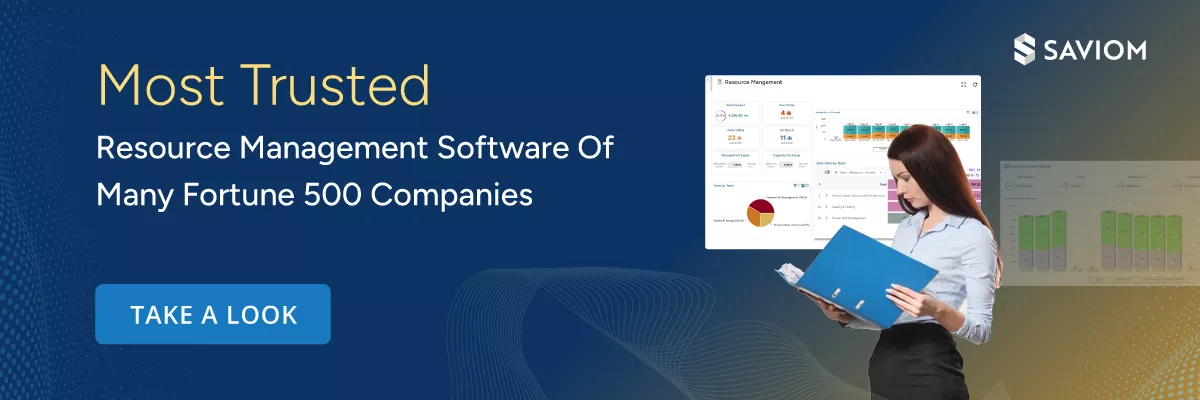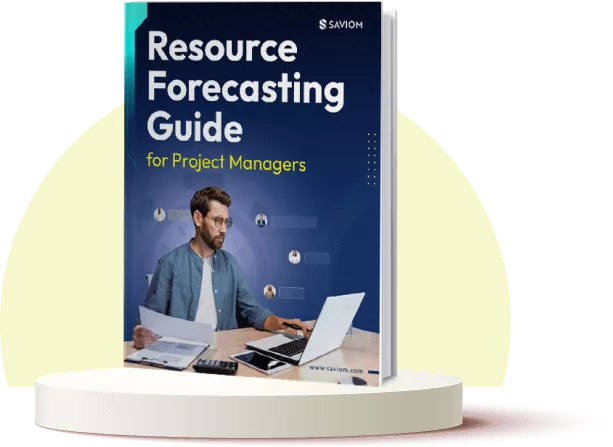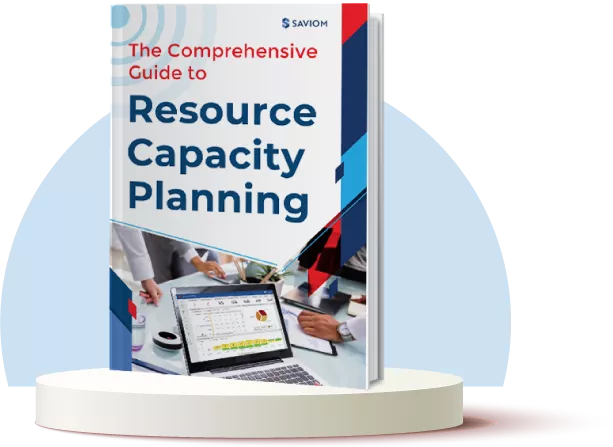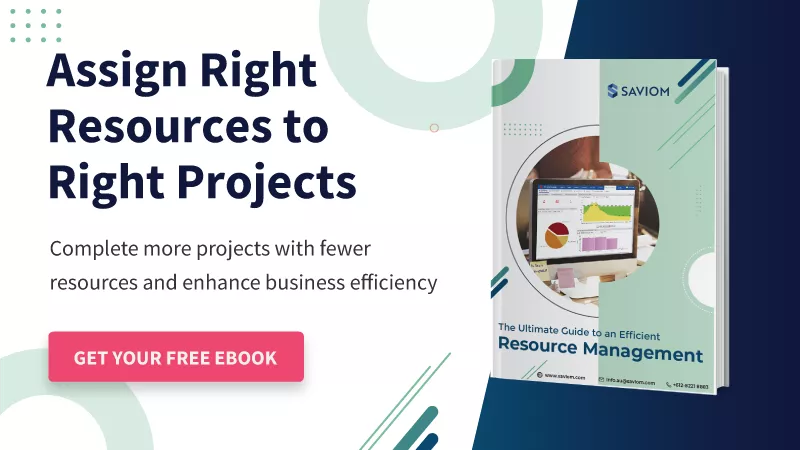Introduction: Building a Future-Ready Organization
In today’s volatile business landscape, uncertainty is the only constant. Resource managers, PMO leaders, and strategists are under immense pressure to deliver predictable, well-aligned business outcomes while staying agile enough to pivot as markets evolve.
However, despite this growing complexity, many organizations still rely on outdated, reactive resource-planning methods. Instead of anticipating future resource needs, teams scramble to find the right people after a project is approved. This often results in employee burnout, budget overruns, missed deadlines, and lost growth opportunities.
To overcome these challenges, organizations are shifting toward proactive resource planning (PRP) that helps them foresee upcoming demands before they arise.
It empowers leaders to confidently build an optimized workforce, mitigate delivery risks, and boost business performance. This blog sheds light on the fundamentals of proactive resource planning and how it positions your organization for unparalleled resilience and long-term success.
But first, let’s have a look at the proactive resource planning definition:
What is Proactive Resource Planning (PRP)?
Proactive resource planning (PRP) is a strategic process of identifying, forecasting, and allocating people, equipment, tools, and finances well in advance to optimize resource performance and drive sustainable business growth.
Unlike a traditional, reactive framework, proactive resource planning strategically aligns resource capacity to the organization’s overarching business objectives to achieve overall goals effectively. It also offers a clear, long-term view that enables leaders to make informed decisions on hiring, upskilling, outsourcing, and adjusting the strategic portfolio. It shifts the focus from ‘who is available now?’ to ‘who do we need and when do we need them?’
The result? Proactive resource planning mitigates critical delivery risks, optimizes organizational performance, strengthens business agility, boosts long-term growth, and enhances market resilience.
Now that we know what is resource planning, the next step is understanding why it matters and the tangible value it creates across the business.
Key Benefits of Proactive Resource Planning
Proactive resource planning (PRP) moves beyond simple scheduling. It creates strategic value across the organization by improving efficiency, strengthening financial performance, and increasing market responsiveness. Below are the key benefits of resource planning:
- Timely Access to Critical Resources: Proactive project resource planning ensures the crucial lead time necessary to secure specialized talent, funding, or external contractual support. This ensures that strategic initiatives are staffed with the right people at the right time and at the right cost.
- Optimized Resource Utilization: By accurately matching capacity to forecasted demand, proactive resource planning significantly reduces under- and over-utilization of resources. This ensures that every team member is working on the highest-value initiatives and boosts organizational efficiency.
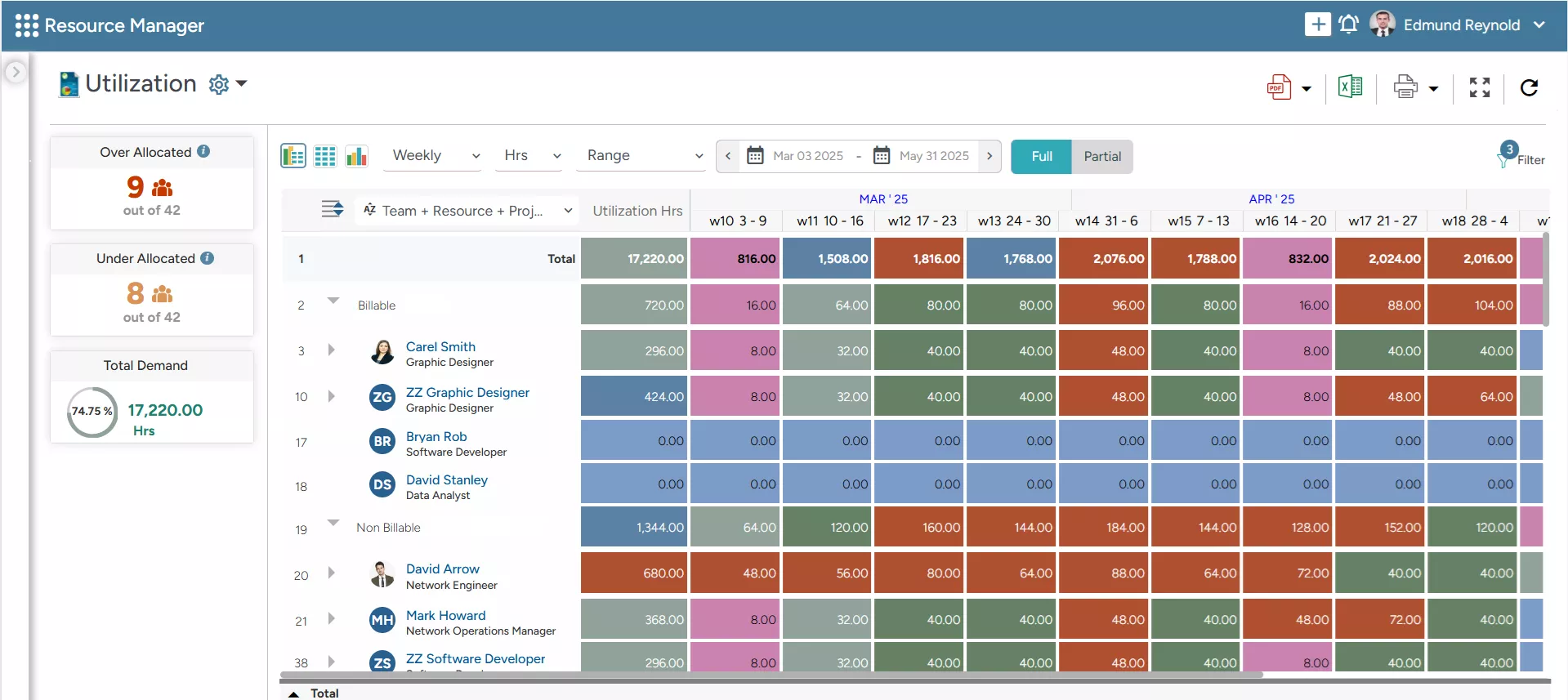 SAVIOM’s Color-Coded Heatmap highlights the real-time resource utilization levels, helping managers identify imbalances and optimize productive utilization.
SAVIOM’s Color-Coded Heatmap highlights the real-time resource utilization levels, helping managers identify imbalances and optimize productive utilization.
- Enhanced Business Agility: When market conditions change, proactive resource planning offers forward visibility that allows organizations to reallocate resources quickly and strategically. This agility enables organizations to pivot rapidly, fast-track high-priority projects, and delay or cancel lower-priority work without disrupting internal stability.
- Driving Sustainable Financial Growth: Strategic resource planning is directly correlated with project success rates and profitability. By optimizing labor costs, mitigating resource gaps, and maximizing revenue-generating capacity, it acts as a powerful lever for sustainable financial growth.
- Risk Reduction in Volatile Markets: In an unpredictable economy, proactive resource planning identifies potential resource-centric risks well in advance. This early visibility allows PMO leaders to implement and mitigate risks, whether through cross-training, contingent staffing, or adjusting portfolio timelines.
- Future-Proofing with PRP Frameworks: Proactive project resource planning is an exercise in strategic foresight. It forces firms to look beyond the current quarter, assessing future skill requirements and capital needs to remain competitive. This helps the business remain resilient amid emerging markets and technological shifts
- Catalyst for Innovation: When resources are managed proactively, it gives teams the necessary bandwidth to dedicate time to non-billable, high-impact activities like training, R&D, and process improvement. This is essential for fostering a culture of continuous innovation and adaptability.

To unlock these proactive resource planning benefits consistently, organizations must be grounded in a strong set of core principles. Read on:
Core Principles: The Building Blocks of Effective PRP
Proactive resource planning is not a software solution; it is a management philosophy built on several interconnected core principles:
Strategic Alignment and Value-Based Prioritization
The primary function of proactive planning of resources is to ensure that limited resources are always deployed against projects that deliver maximum strategic value. This requires a rigorous, data-driven prioritization framework that moves beyond “first-come, first-served.” Read on to understand how PRP enables this alignment in practice.
- Understanding Prioritization Frameworks: Strategic alignment in proactive resource planning (PRP) relies on proven prioritization techniques like weighted shortest job first (WSJF) or a balanced scorecard. PRP provides crucial resource data like cost, availability, niche skills, etc., needed to make these models truly effective and feasible.
- Proactive Demand Forecasting and Capacity Planning: It involves continuous forecasting of future resource needs based on the sales pipeline, strategic roadmap, and estimated project effort. Simultaneously, it requires an accurate insight into the firm’s available capacity by accounting for non-project time such as PTO, training, & overhead.
- Maintaining Contingency Capacity and Blended Workforce: Proactive project resource planning recommends setting aside 10-15% of capacity as contingency for unexpected, high-priority work. Further, maintaining a blended workforce of freelancers, nearshore, or offshore teams ensures the flexibility to scale up or down without costly last-minute hiring.
- Continuous KPI Monitoring and Performance Optimization: In practice, PRP is a continuous cycle, not a one-time event. By monitoring KPIs such as forecast accuracy, resource utilization, and time-to-staff, leaders can identify discrepancies early and adjust the strategic resource planning models ahead of the curve.
Want to learn more about capacity planning? Dive in:
- 5 Effective Steps to Measure Resource Capacity and Demand
- Top 9 Capacity Planning Challenges & Ways to Overcome Them
- The Fundamentals of Agile Capacity Planning: A Guide
Human-Centric Approach to Resource Planning
While driven by data, PRP must never treat people as interchangeable commodities. A human-centric approach acknowledges that skills, motivation, and burnout are key variables in capacity. This involves considering individual development goals, managing workloads sustainably, and investing in continuous upskilling to close future skill gaps identified through resource forecasting. Properly implemented proactive resource planning views people as assets to be developed, not simply variables to be managed.
Now that we have explored the core principles of the resource planning process, let’s dive into its various core elements.
Key Elements of Proactive Resource Planning
Successful proactive resource planning integrates several interconnected components that ensure agility, efficiency, and organizational resilience. Let’s explore them below.
| Element | Description | Authority Tip |
|---|---|---|
| Centralized Resource & Skill Inventory | A single source of truth for skills, certifications, locations, and commitments. | Keep data accurate and up to date through self-reporting, assessment, and validation. |
| Proactive Demand Forecasting | Translate strategic goals and pipeline into quantifiable resource needs (e.g., 3 Senior Java Developers). | Maintain a rolling 3-12 months forecast horizon. |
| Strategic Capacity Planning | Align forecasted demand with available supply to identify gaps and surpluses. | Use insights for proactive and targeted training and hiring decisions. |
| Standardized Request & Allocation | A clear, centralized process for resource requests to prevent shadow allocation. | Prioritize based on strategic value, ROI, and profitability. |
| Utilization Forecasting & Optimization | Predict future utilization and apply strategies like load-leveling to reduce overtime. | Monitor and improve forecasting accuracy for effective resource planning. |
| Scenario Planning & What-If Modeling | Model impacts of events like contract wins or budget cuts to prepare contingency plans. | Example: Accelerating a project may cost $50K in contractors but avoid $500K loss. |
| Real-Time Performance Monitoring | Track KPIs, time entries, and task completion for immediate adjustments. | Use dashboards for real-time visibility and faster decision-making. |
| Proactive Risk Mitigation | Automated alerts for workload thresholds or skill gaps to prevent failures. | Example: Alert when utilization exceeds 110% for 1 month. |
| Integration with PPM & Enterprise Systems | Connect PRP with PPM, HR, and financial tools for seamless workflows. | Ensure data consistency and enforce a single source of truth. |
| Collaboration & Workflow Automation | Automate routine tasks and enable transparent communication across teams. | Use tech to reduce manual effort and improve alignment. |
Now that we have explored key elements, let’s take a look at the common resource planning challenges organizations face and the best ways to address them.
Common Resource Planning Challenges and How to Overcome Them
Implementing PRP is a transformational change, and organizations frequently encounter predictable hurdles. Recognizing these common resource planning challenges is the first step toward effective implementation.
Inaccurate Demand Forecasting Issues
Inaccurate forecasts driven by optimistic sales projections or weak estimation methodologies can undermine the entire proactive resource planning process.
Solution: Establish a standardized, data-driven resource estimation process. Ensure PMs provide demand forecasts based on defined phases, not just high-level guesses. Also, cross-validate demand with the sales pipeline, finance approvals, and historical performance data to apply a buffer until project teams prove consistent accuracy.
Last-Minute Resourcing Chaos
When resource allocation is fragmented or delayed, chaos ensues. PMs hoard resources, and resource managers are perpetually in ‘firefighting’ mode.
Solution: Centralize resource management authority to streamline decision-making. Introduce a “soft-booking” process early in the project lifecycle (pre-approval) and enforce mandatory “hard-booking” only after final strategic sign-off. This creates healthy friction, preventing overcommitment and last-minute chaos.
Breakdown of Communication Barriers Across Teams
Siloed organizations struggle with proactive planning because resource managers lack visibility into department priorities, and project managers don’t trust central data.
Solution: Set up a regular, cross-functional resource governance committee (RGC) meeting with representatives from PMO, HR, Finance, and other departments. The committee ensures a transparent review of demand, capacity, and resource allocation of decisions while formalizing communication across teams.
Resource-related Risks from Poor Capacity Planning
According to a McKinsey report, “90% of leaders consider capacity planning a pressing to-do that needs addressing now or soon.”
Failing to account for non-project work, planned time off, and operational overhead results in an inflated view of available capacity, leading to over-commitment and failed projects.
Solution: Mandate full visibility into the time spent, including administrative, training, and sales support, logged or planned. Further, it is imperative to calculate capacity based on available billable/strategic hours, which automatically discounts non-working time, not total hours.
Budget Overruns Caused by Poor Planning
Poor resource planning directly leads to expensive overruns, using external contractors unnecessarily, paying excessive overtime, or delaying projects.
Solution: Before approving any major hiring or contracting decision, the resource plan must demonstrate the necessity, duration, and cost-benefit analysis. For example, forecasting a Senior Engineer gap 9 months ahead lets the team hire and train for $70,000 a year instead of spending $150,000 on a six-month contractor.
 SAVIOM’s Forecast vs. Actual Report highlights estimated vs. actual time spent on tasks, helping managers identify variances and implement course-corrective measures.
SAVIOM’s Forecast vs. Actual Report highlights estimated vs. actual time spent on tasks, helping managers identify variances and implement course-corrective measures.
Difficulty Building a Culture of Continuous Improvement
Treating the proactive resource planning framework as a static document sets it up for failure. It is necessary for it to evolve with the business.
Solution: Schedule quarterly reviews of the proactive resource planning process. Managers must track metrics like forecast accuracy rates and use the data to continuously refine estimation models and governance rules.
Knowing the challenges, we can now move on to the key steps needed to put proactive resource planning into practice.
Key Steps for Proactive Resource Planning
To shift from reactive staffing to proactive planning, organizations must follow a clear set of PRP steps backed by leadership support and PMO discipline.
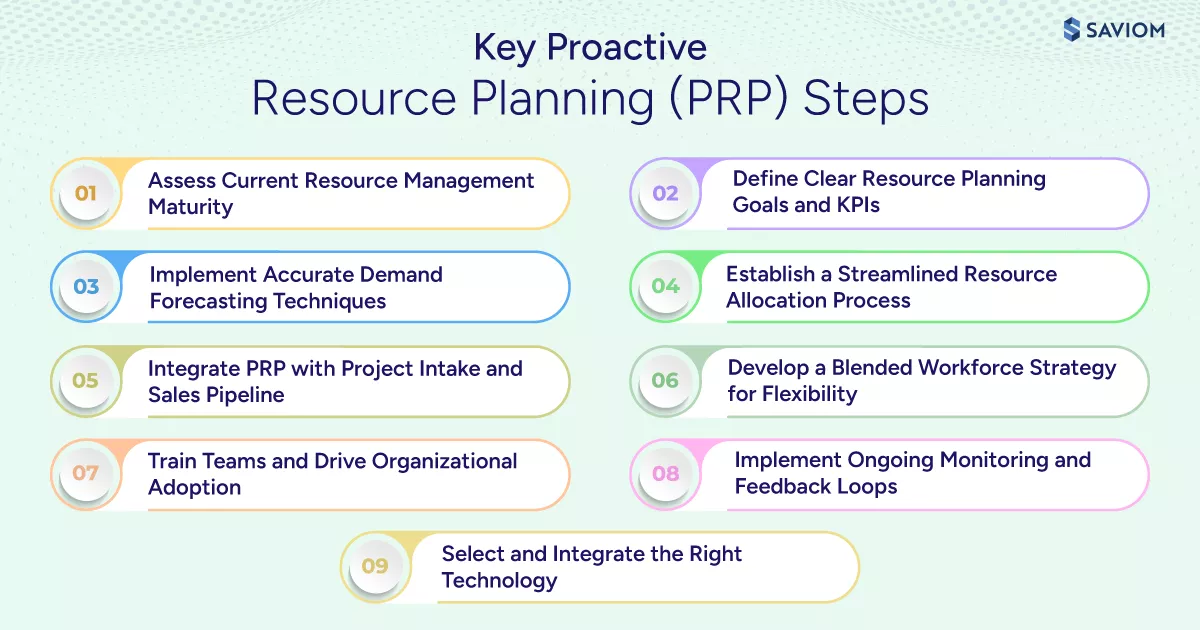
Step 1: Assess Current Resource Management Maturity
Start by determining where your organization sits on the maturity scale (e.g., ad-hoc, consistent, optimized). Subsequently, evaluate existing processes for project intake, demand estimation, allocation, etc. Further, identify pain points like project delays, employee burnout, or resource contention to set up a baseline for success.
Dive in: How to Accelerate Your Resource Management Maturity Model?
Step 2: Define Clear Resource Planning Goals and KPIs
Set measurable objectives aligned with business strategy, e.g., increase utilization from 60% to 80%, cut time-to-staff by 50%, or improve forecast accuracy to 90%. These goals must be shared and owned by both the PMO and functional department heads.
Step 3: Implement Accurate Demand Forecasting Techniques
Firms must standardize project scoping and estimation practices. This includes using techniques like T-shirt sizing for early estimates and shifting to detailed sizing once projects are approved. Additionally, they must enforce a rolling 12-month minimum forecasting horizon to provide critical lead time for hiring.
Learn more: What is Demand Planning & Why is it Important for Businesses?
Step 4: Establish a Streamlined Resource Allocation Process
Build a formal governance structure, centralize resource manager roles, and implement standardized request/approval workflows (soft vs. hard booking). The approval should hinge on strategic value and resource availability, not just executive whim.
Step 5: Integrate PRP with Project Intake and Sales Pipeline
Ensure the sales pipeline feeds resource forecasts in real-time. With this insight, no project shall pass final approval without a resource feasibility check that proves the capacity exists without disrupting existing high-priority work.
Continue reading: What is a Project Intake Process & How to Improve It?
Step 6: Develop a Blended Workforce Strategy for Flexibility
Define your core roles to keep them in-house while outsourcing non-core roles for flexibility. Then, pre-negotiate contracts to access specialized capacity quickly. This strategy is essential for managing capacity peaks and valleys efficiently.
Step 7: Implement Ongoing Monitoring and Feedback Loops
Managers must hold weekly or bi-weekly resource meetings. They must compare actual effort vs. forecast and use variance data to improve estimation accuracy. This continuous feedback loop is what transforms planning from static to proactive.
Learn more: 7 Proven Ways to Give Constructive Feedback to Your Employees
Step 8: Select and Integrate the Right PRP Technology
According to a PMI survey, “26% of companies with a dedicated resource planning solution can estimate and allocate resources to deliver projects on time.”
Choose technology that supports centralized inventory, advanced scenario planning, and seamless integration with PPM and time-tracking systems. In addition, ensure the tool includes a robust reporting engine that can aggregate data by role, skill, and strategic alignment, not just by individual projects.
Step 9: Train Teams and Drive Organizational Adoption
As per The Future of Jobs Report, 2025, “Upskilling is among the top three priorities across economies and geographies at all income levels.”
Train project managers on request workflows, department heads on capacity reports, and secure visible executive buy-in to enforce adherence. Proactive resource planning succeeds only when the technology supports the larger 80% change-management effort.
Dive deeper: How Can Retraining/Upskilling Future-Proof Your Workforce?
Read on to see which KPIs drive the most value and how they help leaders measure performance, strengthen decision-making, and ensure that they deliver meaningful results.
Defining Success Metrics for Proactive Resource Planning
The success of PRP should be easy to measure. When you track the right key performance indicators (KPIs) and clearly show the ROI, it becomes much easier to demonstrate why the effort truly matters.
| Category | KPI | Description |
|---|---|---|
| Resource Utilization & Efficiency | Target Utilization Rate | Percentage of time on billable or strategic work (e.g., 75%). |
| Non-Project Time % | Planned time for training, admin, or sales support (15–20%). | |
| Workforce Productivity Metrics | Value Delivery Rate | Ratio of completed strategic projects to those initiated. |
| Demand Forecast Accuracy | Forecast Accuracy | How closely estimated resources need to match actual usage (e.g., ±10%). |
| Cost Savings & Budget Adherence | Premium Labor Cost Reduction | Lower spending on overtime, emergency contracting, or last-minute hires. |
| Budget Variance | Difference between planned and actual resource costs. | |
| Project Delivery Performance | On-Time Delivery Rate | The percentage of projects completed on or before the planned date signals PRP success. |
| ROI for PRP Initiatives | ROI Metrics | Higher revenue capacity, lower costs, and stronger risk mitigation. |
| Agility Metrics | Time-to-Staff Priority Projects | Time from approval to confirmed resource allocation, aim for near zero. |
| Resilience Metrics | Contingency Capacity Utilization | Frequency of buffer usage, showing shock absorption. |
| Resource Burnout Index | Tracks high utilization (>100% for >3 months) to prevent burnout. |
With core resource-centric metrics in place, let’s now explore how PRP adapts to the unique demands of each industry.
Industry-Specific Applications of Proactive Resource Planning
While the proactive resource planning principles are universal, their application can be tailored to industry-specific demands.
- PRP for Professional Services and Consulting Firms: Here, the primary resource is billable consultant time. PRP helps maximize billable resource utilization rates, minimize expensive bench time, and accurately forecast pipeline demand to manage long hiring cycles.
- Case Example: An IT consulting firm used PRP to identify a 20% skill gap for an upcoming enterprise resource management project in Q4. With this insight, they hired four contractors in advance, preventing the loss of a $1 million engagement and avoiding client churn caused by capacity shortages.
- PRP Strategies for Financial Services and Banking: These industries rely on highly specialized, finite resources such as analysts, risk managers, etc. However, PRP helps prioritize regulatory and compliance initiatives, reducing the risk of costly penalties and deadlines.
- PRP for Audit and Accounting Services: The major challenge is managing extreme seasonality (e.g., tax season). PRP helps balance workloads in non-peak periods and ensures enough contingency capacity during peak season to handle unexpected client requests.
- PRP in Architecture, Engineering, and Construction (AEC): PRP must account for both human resources and specialized assets such as CAD licenses, heavy machinery, and materials. Accurate resource planning and capacity forecasting is essential for multi-year, fixed-bid contracts where costs and timeline need to be locked up front.
- PRP Applications in IT and Software Development: Focuses on managing specialized skill stacks (e.g., Python, Net, Cloud Architecture). Demand forecasting must integrate with the agile product roadmap, anticipating upcoming product updates and ensuring the right talent is available for the next sprint.
- Adapting PRP for Government and Public Sector Operations: The focus shifts from profitability to managing grant funding and political mandates. PRP is used to justify budgets by proving that the required capacity exists to deliver on public commitments and utilize taxpayer funds efficiently.
- Leveraging PRP for Healthcare Workforce Management: It is critical for maintaining safe staff-to-patient ratios, reducing clinical risks, and managing rotating shift schedules. It helps build a resilient workforce plan that can handle unpredictable patient volumes and maintain mandatory certifications.
Several emerging trends are driving its next stage of proactive resource planning transformation. Let’s understand the innovations shaping this evolution in detail.
Emerging Trends in Proactive Resource Planning
Advancements in AI and automation are transforming proactive resource planning (PRP) from human-led prediction to system-driven foresight. Here is how:
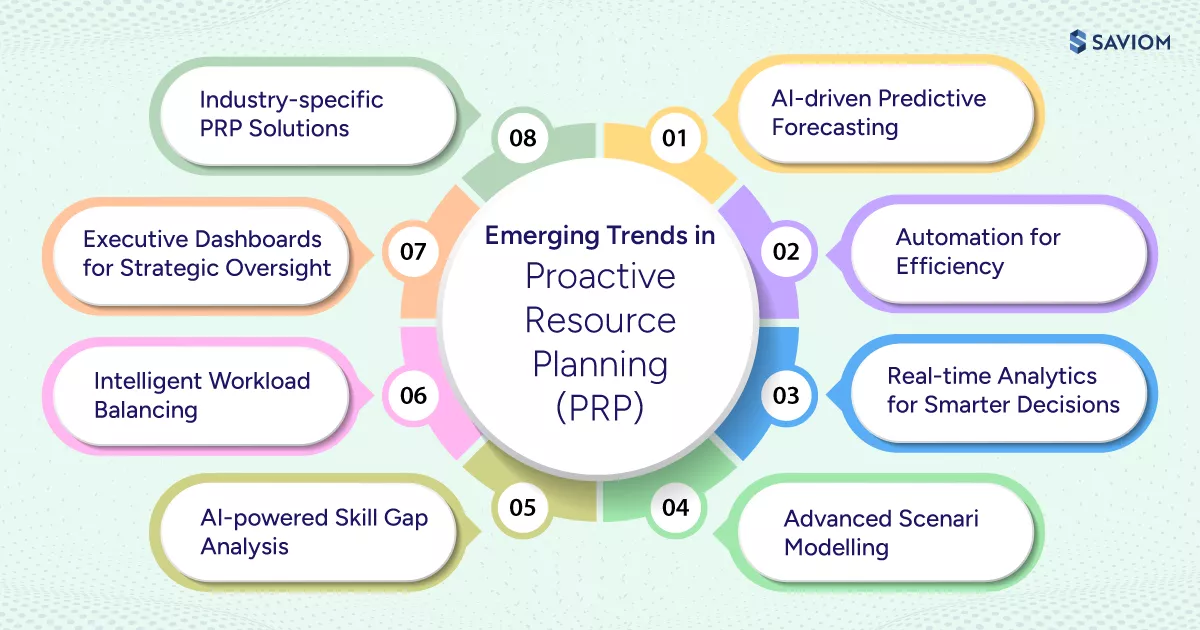
- AI-Driven Predictive Forecasting
Machine learning analyses historical project data, sales velocity, and team performance to generate precise demand forecasts. This eliminates human bias and moves the organization beyond simple averages toward true predictive analytics. - Automation for Efficiency
Tasks such as CRM/PPM data syncing, resource availability checks, and status reporting are automated, freeing resource managers to focus on strategic decision-making. - Real-Time Analytics for Smarter Decisions
Modern PRP platforms leverage cloud and in-memory computing to process massive datasets instantly, enabling managers to make informed allocation decisions on the fly. - Advanced Scenario Modeling
Modern tools allow firms to model multiple “what-if” scenarios, helping organizations choose the best responses before challenges arise.
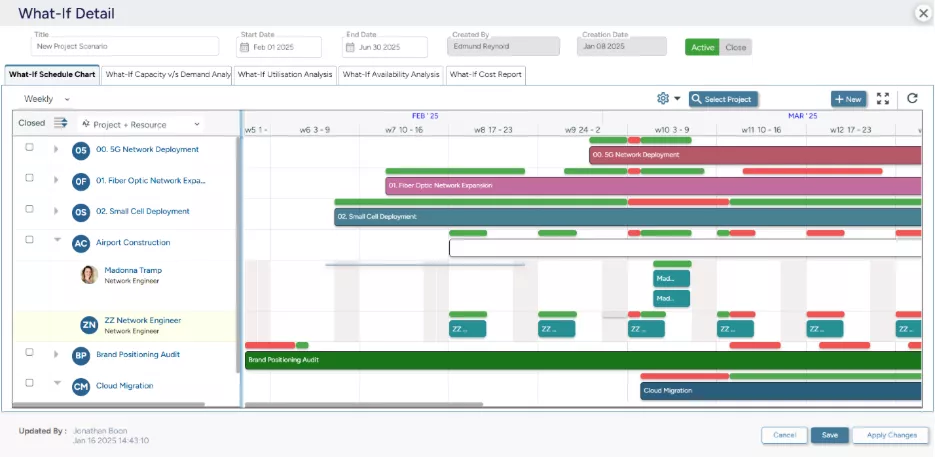 SAVIOM’s Scenario Modeling functionality allows managers to simulate and test multiple workforce scenarios in a sandbox environment.
SAVIOM’s Scenario Modeling functionality allows managers to simulate and test multiple workforce scenarios in a sandbox environment.
- AI-Powered Skill Gap Analysis
Automated systems scan resumes, training records, and performance data to predict future skill shortages months ahead, enabling proactive hiring and upskilling. - Intelligent Workload Balancing
Smart alerts and automated adjustments redistribute tasks when thresholds are reached, preventing employee burnout and keeping resource utilization optimized. - Executive Dashboards for Strategic Oversight
Personalized dashboards offer real-time visibility into resource health, portfolio capacity, and financial risk, ensuring leadership stays aligned. - Industry-Specific PRP Solutions
Vendors now offer tailored PRP platforms for sectors like consulting, IT, AEC, and more, designed to match each industry’s workflows and resource constraints.
